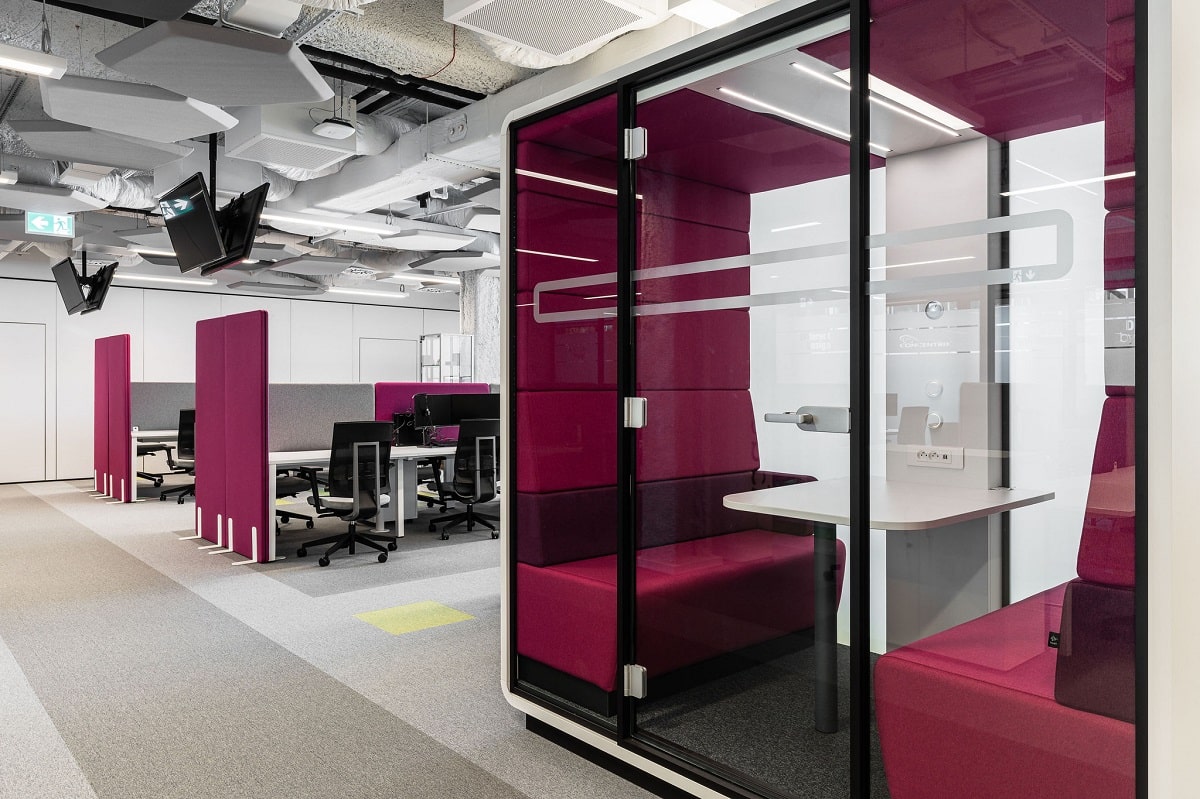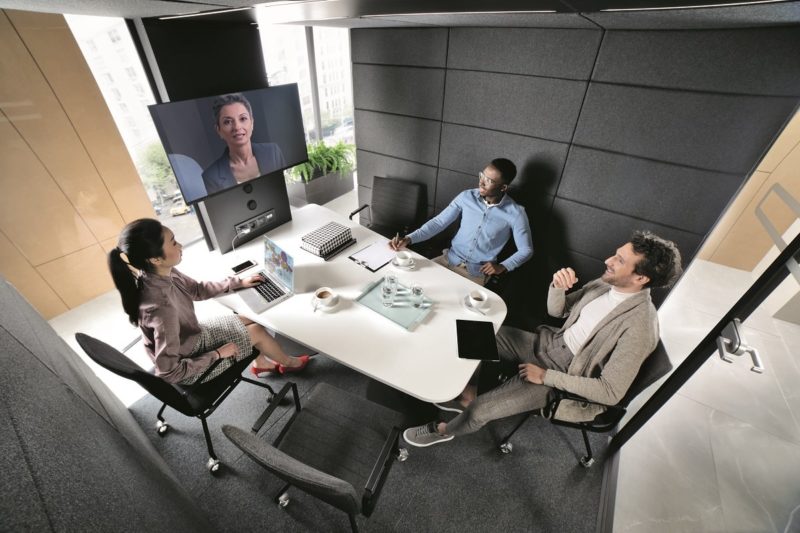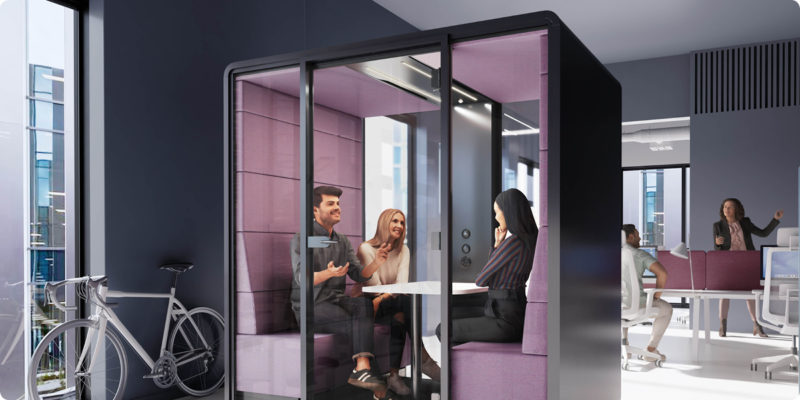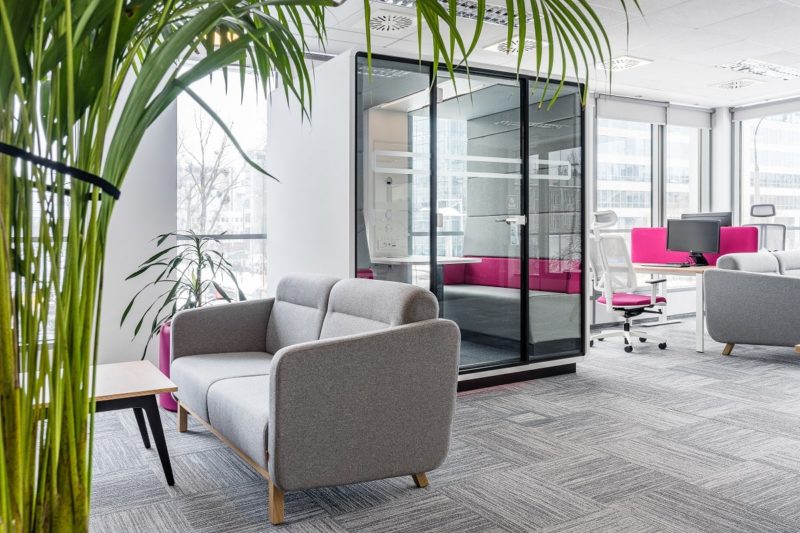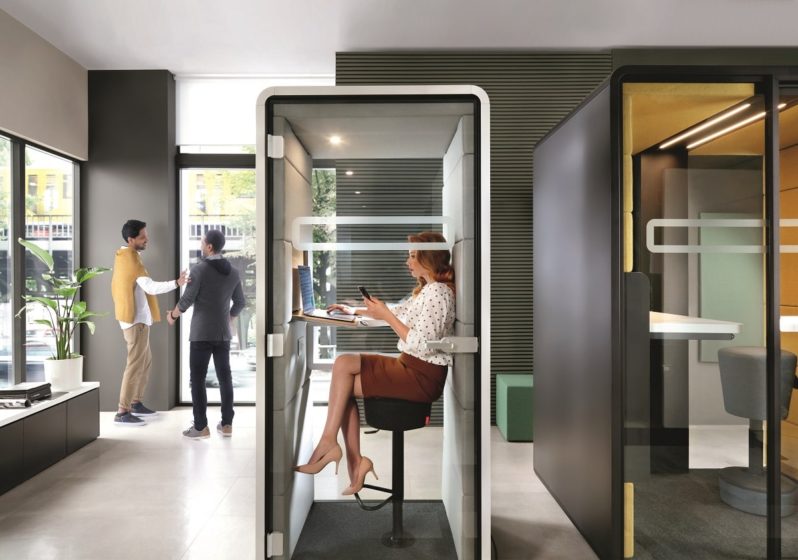An activity-based workplace (with the help of office pods)
- Posted on: 19 December 2023
- By: Hushoffice Team
Activity-based working is becoming popular. It is a method that can meet employee needs while saving costs. But what are the philosophy’s advantages and disadvantages? And how can you boost the success of an ABW mode through the office’s design? Let’s see.
An activity-based workplace – tl;dr
Activity-based working (ABW) is a workstyle and organizational framework that opts for task-specific environments over assigned workstations. Formed by an ABW approach, the office is divided into discrete zones, each of which caters to a specific set of activities. This diversification gives the employee more autonomy over their workday, letting them pick the environment best-suited for each moment’s task.
Research indicates that the pitfalls of ABW are more related to how well the way of working is implemented in the physical office and how occupants use it than the concept itself. Put simply, the effectiveness of activity-based working depends largely on how well the office environment supports it. Interestingly, one study found the comfort of furnishing to be the single strongest predictor for self-assessed health of employees in an activity-based workplace.
Generally, an ABW workplace features collaboration areas, open lounges, huddle zones, project tables, cafes, communal workspaces, conference rooms, and quiet booths such as Hushoffice pods to fulfill the employee’s scope of needs.
What is activity-based work (ABW)?
Activity-based working (ABW) is a workstyle and organizational framework. It prioritizes task-specific environments over fixed desks. In such an office, employees are free to choose from a selection of work settings — from collab areas to quiet zones to work pods like hushHybrid — per changing tasks.
Task-focused and thus individualized, an ABW approach to the office’s layout is becoming more common as it can help to optimize space utilization, to cater to many work styles, and, ultimately, enhance overall organizational efficiency and team satisfaction
– says Mateusz Barczyk, Senior Brand Manager, Hushoffice.
Activity-based working is changing the workplace
Applied to the office’s layout, ABW becomes a human-centric design ethos devoted to giving employees a plentiful of spaces to work, meet, and relax. Ideally, these work settings are flexible and reconfigurable with moveable furniture for maximum user-adaptability.
Every organization’s range of work settings will differ from the next
But in general, an ABW workplace features collaboration areas, open lounges, huddle zones, project tables, cafes, communal workspaces, conference rooms, private lounges, quiet nooks and phone pods such as hushPhone.
What are the shortcomings of ABW environments?
Drawbacks are shown to be more related to how effectively this way of working is implemented in the physical office and how occupants use it than the concept itself. In other words, the success of activity-based working depends largely on how well the office environment supports it.
Employee-led retrofits and adjustments to the layout are key
One review of research in activity-based working over the last ten years found that after switching to an ABW-supportive environment, a continuous evaluation of employee sentiments regarding the office’s functionality is needed to gauge and respond to changing needs and preferences, making ABW working a success.
Advantages of an activity-based working office arrangement are many
ABW promotes flexibility, allowing employees to choose workspaces that align with their tasks. It can also streamline space by eliminating the need for assigned desks. When people can easily switch between individual focus, group work, and relaxation, productivity and well-being are bettered too.
So what do employees need, regardless of their position and specialty?
Simply, they need the autonomy and support to work how they work best. Activity-based working is a promising approach because it affords autonomy by supplying a range of work environments to pick from in the office and the freedom to switch up spaces as appropriate to each workday.
Activity-based workplace design means carefully planning every part of the office to support different working styles and tasks
– adds Mateusz Barczyk, Senior Brand Manager, Hushoffice.
The future of work is flexible and people-based
34% of employees say lacking flexibility limits their productive output. Among this 34%, a common request is for the option to pick work environments — both inside and outside the office. It turns out in-office flexibility is actually a major factor in employee performance.

Multiple generations with different working styles
Different generations want different things from the office. Traditionalists seek private meeting spaces. Millennials like a resimercial look. Gen X loves open, transparent layouts. ABW can cater to these varying and overlapping needs by creating discrete zones to accommodate each one.
Hushoffice acoustic cabins — tailored to the specifics of the tasks performed
So where do pods enter the picture? Pods are fully featured, all-in-one, movable, private and pleasantly quiet work, meet, and rest spaces. They can be tailored to specific activities, altogether ensuring a team’s entire range of work functions is met by the office’s furniture settings.
Support for different working styles
By framing and understanding tasks according to their category, and defining and fine-tuning environments to support each one, you slowly but surely craft work environments within the office that accommodate a spectrum of work styles
– offers Mateusz Barczyk, Senior Brand Manager, Hushoffice.
Eliminate silos, improve team relations
Watercooler chat can balance collaborative conversations by fostering reciprocity. When people chit-chat while working together, either party gets their two cents in, enjoying a two-way flow of conversation. This simple phenomenon is associated with higher levels of task enjoyment.
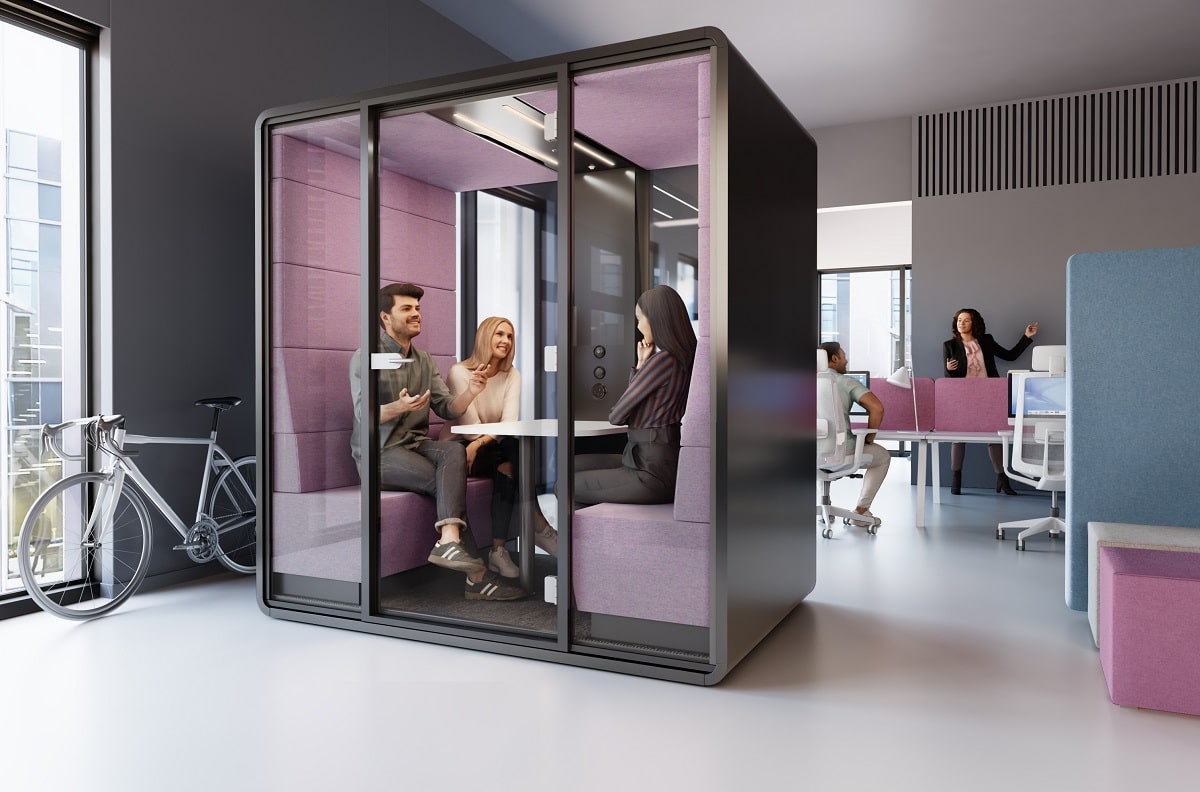
Autonomy in the workplace brings many benefits
On average, organizations that transition to Activity Based Working see a 17% improvement in overall workplace satisfaction, 13% increase in individual productivity, 8% growth in team productivity, 11% gains in organization culture and 4% boost in sense of community in the workplace.
But the success of activity based working depends on many factors.
The leading research shows that the results of ABW working are influenced by alignment between employees’ way of working and the support received from their work environment, the employees’ authentic sense of choice, and the workstyle flexibility and mobility enabled by organizational culture.
Private workspaces are essential to a thriving activity-based office space
ABW can indeed increase the frequency of personal, interdepartmental, and informal communication among employees and managers, thus boosting performance and creativity. But the data shows a clear caveat: unless some closed workspaces are provided, an open layout distracts, inhibiting focus.
Indeed, the right furniture makes (or breaks) activity-based working
Furniture communicates each work setting’s purpose, making the office more intuitive. If it communicates poorly, your team won’t have ease navigating their office, and will experience confusion about how it should be used.
Just how much does furniture matter?
One study found comfort of furnishing to be the single strongest predictor of employee health in an ABW office. It is in light of such findings that our team loves to show off our Hushoffice family of booths which are beautifully upholstered and finished with ergonomically correct furniture.
Acoustic cabins — areas for cooperation, interaction, recreation and concentration
In sum, the office must accommodate top employee wants and needs to succeed in evolving an organization to an ABW mode. Pods and booths help this evolution by dividing open space into single zones for discrete activities, all the while giving the floor a healthy amount of privacy and quiet.
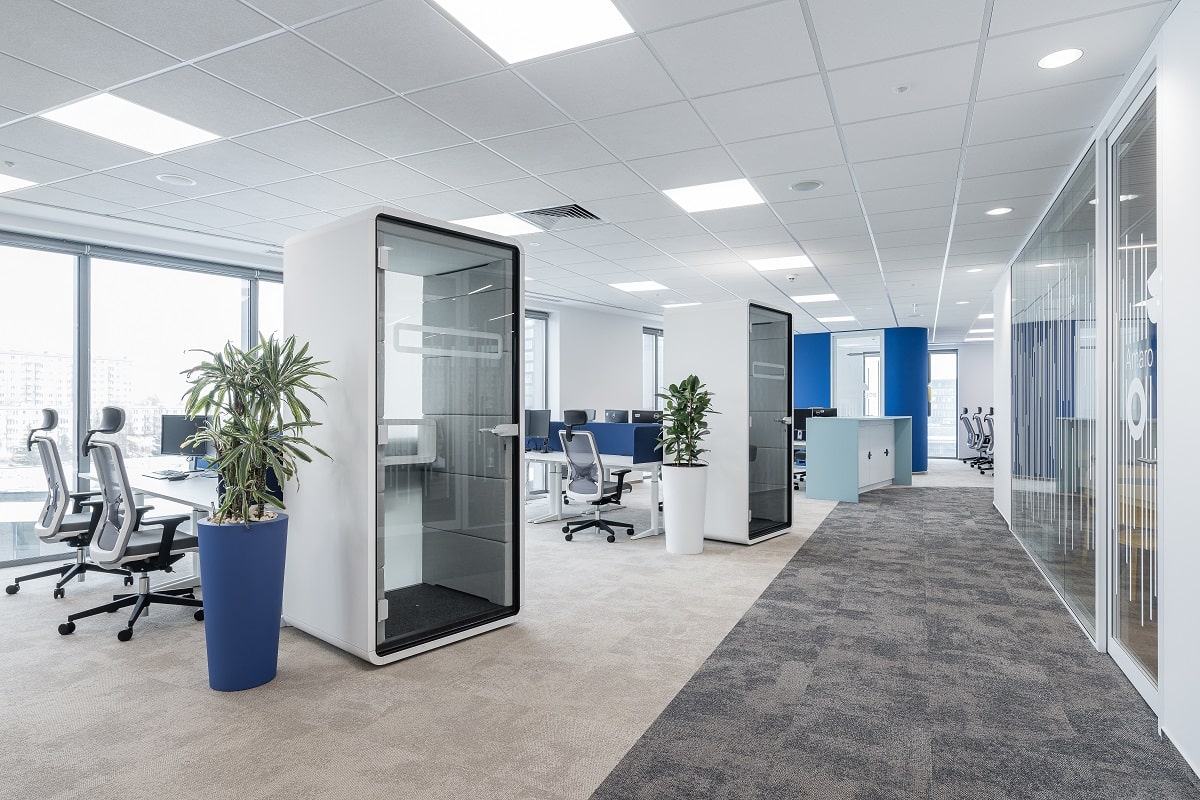
Focus room, places to work in silence
Almost 80% of office workers say their productivity is dependent on if they have a quiet and private space to work. A one-person booth like hushHybrid is a perfect private workspace — it is comfortably furnished and complete with all the features needed for focused efforts in a noisy office.
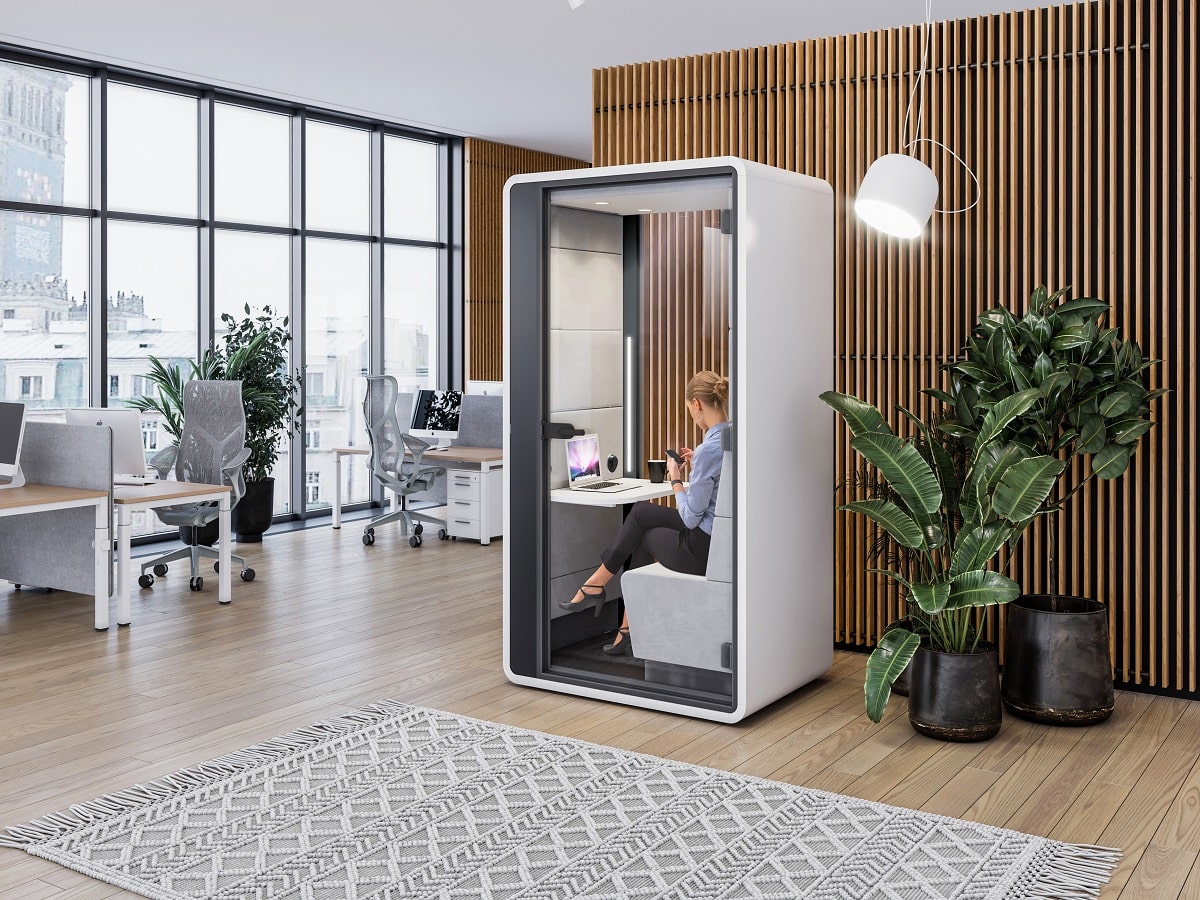
Instead of emailing, talk
Digital overload can lead to irritability, anxiety, and mood swings. At the same time, face-to-face communication is one of the most efficient ways to satisfy one’s need for social connectedness. HushMeet is a cozy 4-person office pod for the organic discussion everyone needs.
Mini meeting rooms to gather, brainstorm, and deliberate
A quaint booth like hushMeet is a brilliant way to accommodate the employee’s universal need for getting together. It is acoustically engineered to contain all speech made inside, giving confidential matters discretion. The booth’s self-contained design makes for a privacy haven, too.
Relaxation zones in the office are a spot to catch your breath
Often, all that is needed to recharge is to tune out all the figurative (and literal) noise for a few minutes. A booth like hushAccess.L is carefully made to do just that. From inside the structure, sound from the floor is heard as a gentle, soothing murmur.
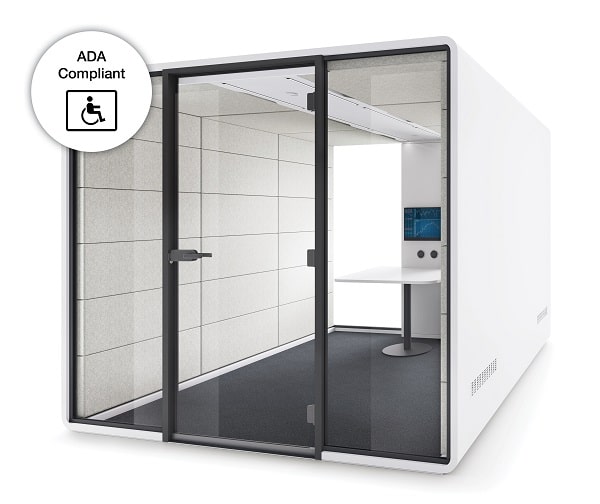
Offices of the future — several types of space and the choice left to employees
The data agrees that spatial factors are what largely determine the success of an ABW workplace — factors such as ease of interaction in the office, the ability to adjust one’s workspace, and the amount of storage space provided. The essentiality to ABW of adequate furniture and a thoughtful layout truly cannot be overstated!
Ultimately, today’s office must cater to the employee’s burgeoning desire for choice.
Start smart and slowly diversify your open office by dividing it into functional, feng shui zones meant for given needs, both work- and health-related. By affording options complete with well-suited furniture settings, you will allow employees to find their own flow within the workplace.
Want to read more? Learn how activity-based design can boost office ergonomics.
Activity based working – summary
Activity-based working (ABW) is a workstyle and organizational framework that opts for task-specific environments over assigned workstations. Formed by an ABW approach, the office is divided into discrete zones, each of which caters to a specific set of activities. This diversification gives the employee more autonomy over their workday, letting them pick the environment best-suited for each moment’s task.
Research indicates that the pitfalls of ABW are more related to how well the way of working is implemented in the physical office and how occupants use it than the concept itself. Put simply, the effectiveness of activity-based working depends largely on how well the office environment supports it. Interestingly, one study found the comfort of furnishing to be the single strongest predictor for self-assessed health of employees in an activity-based workplace.
Generally, an ABW workplace features collaboration areas, open lounges, huddle zones, project tables, cafes, communal workspaces, conference rooms, and quiet booths such as Hushoffice pods to fulfill the employee’s scope of needs.
Activity based office – frequently asked questions
What is an example of activity-based working?
A prototypical ABW approach is observed in an office divided into zones which are task-specific. Collaboration spaces, work lounges, huddle spots, project tables, cafes, communal benching, conference rooms, and quiet booths such as Hushoffice pods generally make up this array of zones.
What are the principles of activity based work?
The understanding behind activity-based work is that the employee should have autonomy in the office. The idea is that only with autonomy, through options and choice, will the employee be able to find their rhythm within the workplace, working as they work best, with more flow than friction. One of the most concrete ways to afford this autonomy is by diversifying the open office, transforming it into a variety of zones with a variety of work settings for the employee to choose from, cycling through per the nature of each day’s needs.
What is activity based office design?
Activity-based office design, also known as activity-based working (ABW), is a workplace design strategy that prioritizes flexibility and employee autonomy; instead of assigning fixed workstations, ABW aims to create a variety of workspaces meant for specific activities.
